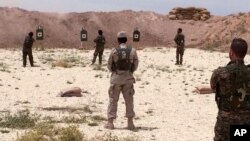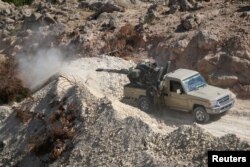The U.S. military's renewed program to train and equip Syrian rebels is helping anti-Islamic State forces make "significant steps forward" across the Syrian battlefield, officials say, as the Pentagon works to evaluate recent changes in the program.
"We have U.S.-trained opposition forces near the Mara line, we have U.S.-trained opposition forces down in the at-Tanf garrison, and we have provided advice, assistance and training to the Syrian Democratic Forces that are conducting the Manbij operation," Colonel Chris Garver, a spokesman for the coalition fighting Islamic State in Iraq and Syria, told reporters Wednesday.
Rather than trying to build entire units, as the Pentagon did in its first attempt at a train-and-equip program, the U.S. military is now focused on training small numbers of fighters as "spotters," who can coordinate resupply efforts and describe enemy positions, according to U.S. officials.
The officials, who spoke on the condition of anonymity, say fewer than 100 Syrian fighters have been trained in the new program, which they described to reporters as a six- to eight-month window of starting "example programs" to build upon.
One official said the revamped plan had been "much more effective" than "trying to build something from the ground up." He noted it also has given the U.S. a better understanding of the Syrian battlefield.
According to another official, the U.S. military currently is supporting about 10,000 Syrian Arabs through the small number of fighters in both the old and new train-and-equip programs.
The official explained that since the Pentagon started coordinating with the Syrian Arab Coalition, or SAC, their numbers "effectively have doubled."
"The goal is growth," the official said. "Success has bred success."
Focused objectives
Part of the program involves vetting the leaders of several opposition groups and supplying their units with weapons — solely focused on one anti-IS objective at a time.
"It's not like we're just flooding their units with enough for multiple operations. It's just enough to get them through the next operation," another official said.
The groups primarily receive small arms and ammunition, along with some communications equipment. The U.S. military also has provided some indirect fire assets and vehicles, according to the officials.
If a Syrian group uses U.S.-provided equipment for other purposes, the military officials say the U.S. would remove its support.
Opposition successes
Officials point to opposition successes in al-Hal, Hasaka, Shadadi and the current operations in Manbij as an evaluation of the program, rather than the numbers trained.
Garver said Manbij was "the hub" of foreign fighter activity in Syria, adding that the coalition has noticed a reduction in Islamic State foreign fighters since the group's heyday last year.
"There was upward of 2,000 [foreign fighters] a month that were coming into Syria and moving into Iraq," Garver said. "We think that the flow is now down to somewhere around between 200 and 500."
Despite the successes, the train-and-equip program remains an expensive endeavor. The U.S. spent $346.8 million in the 2015 fiscal year on the program, and has allotted $416.5 million for the program in the 2016 fiscal year.















